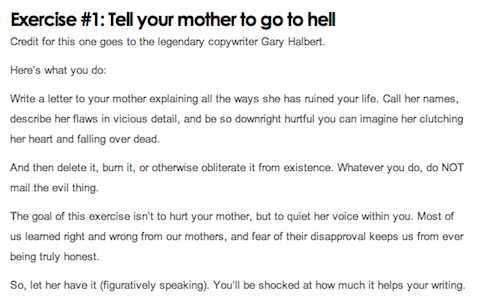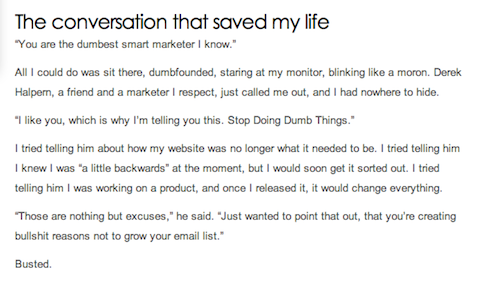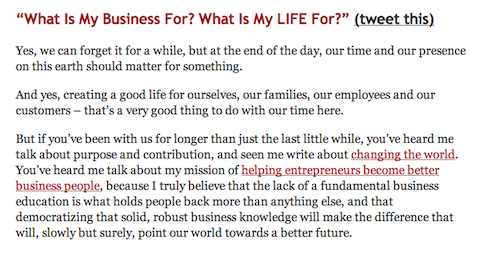
You know you’re in a war, right?
Ok, so no actual guns or tanks are involved, but you are indeed in a bloody battle for the eyes and minds of your readers.
The blogosphere is a huge, congested, noisy space where everyone is jockeying for position and fighting to get noticed.
So to overcome this fact, you’ve done what you’ve been taught to do:
- You’ve come up with great ideas that readers will find useful
- You’ve created killer headlines that jump off the screen and demand attention
- You’ve spent hours writing and rewriting stellar content that delivers and reads beautifully
And yet readers still come to visit your blog and… (click) bounce just as quickly as they came.
Why It Doesn’t Matter How Great Your Content Is
Look, I know you work hard on your writing – and if you study and apply all thegreat writing advice that’s available out there, it’s a safe bet that you’re writing some powerful stuff. Granted.
Suggested :Top WordPress Portfolio Plugins For Creatives Bloggers
And when you know you’re creating legitimately excellent work, you can easily fall into the rainbows-and-unicorns blogging fantasy. You know the one. It goes like this:
- Your readers see a killer headline you wrote on their social media streams and click through to the article.
- When they click through, they read every carefully crafted word from start to finish – devouring the intellectual feast you’ve laid out for them.
- Having fallen head over heels in love with your work, they subscribe, read everything you’ve ever written, and become evangelists for your brand – spreading the word of your excellence far and wide.
Oh, what a wonderful world it would be, right?
But the harsh reality of the situation is this:
They often don’t even finish reading the article that brought them to your blog in the first place.
The Reason Your Readers Don’t Stick Around
Readers have adapted to their environment. You know as well as I do that it’s not exactly uncommon to be lured in by a compelling headline, click through to the article and find weak content.
Because of that, readers have become expert scanners.
We’ve all learned to scan content and determine if it piques our interest in mere seconds. If it doesn’t grab us, we bounce – plain and simple.
According to The Nielsen Norman Group, the vast majority of your visitors will make a judgment within 10 to 20 seconds of opening your content whether they should stick around – or whether they should bounce.
Suggested : Massive – Responsive Multi-Purpose WordPress Theme Bloggers For Stylish Blog
That’s it. Just 10 to 20 seconds. There’s no waiting around for the grand finale in blogging, friends.
Think about it: In 10 to 20 seconds, a good post and a great post look fairly similar. It’s just not long enough to win hearts and minds and create thatendless stream of traffic you’ve been dreaming of.
The Recommended Cure For Scanning (and Why It Doesn’t Work)
The best tool you have in your arsenal is something that far too many bloggers overlook.
The subhead.
That’s right – the often overlooked subhead is really a stealthy and lethal ninja writing weapon just sitting there quietly waiting to be put to good use.
Unfortunately, most writers don’t know how to use them properly.
Let’s do a quick refresher and deconstruct the word.
The name sub (under) head (headline) literally means a headline under the main headline.
And what do headlines do?
They hook, they entertain, they shock, and, above all, they create curiosity. They pull readers further into your epic content so they stay with you long enough to realize that it is, in fact, stellar writing.
What the headline does for the post, the subhead does for each individual subsection of copy.
3 Subhead Blunders That Make Readers Bounce
Too many writers just throw away their subheads. Let’s take a look at the three most common blunders that cause subheads to fall flat.
1. THE PLAIN LABEL SUBHEAD
A lot of bloggers use subheads merely as a label. Labels are used to identify, not to pique interest.
Plain Label Subheads are boring and they don’t stop readers from scanning. They make them yawn. Not exactly the response you’re looking for.
If, for example, you’re writing a subhead above text that’s about why headlines are important and your subhead is Why Headlines Are Important, you’re using it as a label. It’s lifeless, boring, and does nothing to keep your readers engaged with your writing.
Suggested : New In The Field Of Blogging Tis Is How To Get Your First 1000 Readers: Here’s Your Step by Step Plan
Instead, something like The Simple Secret to Hooking Your Readers would be more on track. Then let the text that follows explain the importance of great headlines.
2. THE SPOILER SUBHEAD
Spoiler Subheads tell readers exactly what’s coming in the text that follows the subhead. Talk about playing right into the scanners’ hands! If you want to keep readers on your posts longer, don’t give them a free pass to skip paragraphs. Tease them with the subhead.
Keeping with our example of headlines, if you’ve written a block of text in which your point is that the number-one priority of a headline is to create curiosity, don’t precede it with a subhead that reads Use Headlines to Create Curiosity.
That’s a big old spoiler that gives away your upcoming point. And if they know the point you’re about to make, why should they read it?
A subhead that reads The One Thing Every Great Headline Has in Common would be a much better place to start. Then use the text below it to explain how curiosity is that one thing.
3. THE CRYPTIC SUBHEAD.
The other side of the subhead blunder coin is trying so hard to be creative and grab attention that you create something that is more confusing than compelling. These cryptic subheads can be a turnoff and lead to a bounce just as easily as the other two mistakes.
Your subhead should be a phrase that is crystal clear, but makes readers say, “I have to keep reading to see what this writer’s getting at.” If instead, it makes them say, “What the hell does that phrase mean?” – you’re flirting with being too cryptic.
Suggested : Make Money Using Youtube Video Marketing(100% Working Method) Also Works In Pakistan Urdu And In English Laguage
Again, consider our example topic of headlines. If you’re making the point that a headline acts as a lure, enticing readers into the body of the post, you might make an analogy with fishing and using bait to hook your readers. But out of context, a subhead which reads Don’t Forget the Worm!won’t make a whole lot of sense.
Therefore, it confuses rather than compels and misses the mark completely. Readers don’t want to solve puzzles. They want to learn.
If, instead you used one that reads The Most Powerful Way to Get More Clicks, you’re in the ballpark. You’re making the same point, but the phrasing pulls readers further into your post instead of frustrating them to the point of clicking away.
You need to treat your subheads as another opportunity to stand out, to grab your readers’ attention, and keep them on your site long enough to transform them into fans.
Steal These Moves From The Subhead Honor Roll
Naming names and showing you examples of people who did it the wrong way would just be mean. Entertaining, perhaps, but mean.
So instead, I’m going to share with you three excellent examples of the right way to keep your readers on your blog longer by writing great subheads – and tell you what they did right.
Suggested : Infographic: How Colors Affect Conversions
JON MORROW
Since we’re all here, we might as well pay homage. Jon is one of the all-time masters of headline writing. He has a unique talent for crafting headlines that make you say, “What? What the hell could that possibly be about?” His subheads are just as powerful.
Here’s a doozie:
Wow! That got your attention, right? For a split second when I first read that, I thought, “What could Jon Morrow possibly have against my mother?”
That subhead is kind of surprising, and it shows a uniquepersonality too. It creates curiosity. After reading that, you’re compelled to keep reading to find out what he’s talking about – which turns out to be a great exercise to improve your writing.
If Jon had used his subhead as a label – merely to describe the content below it – it wouldn’t have pulled you in.
A subhead that reads Write A Letter to Your Mom Then Tear It Up falls flat.
If he had told readers what was coming with a subhead likeTry This Writing Exercise, they probably wouldn’t bother to read the paragraphs that followed. They’d just keep scanning – or even worse… bounce.
Suggested : 5 Smart Ways To Keep Visitors on Your Blog Longer That Will Definetly Increase Your Conversions
TOMMY WALKER
In a guest post here on Boost Blog Traffic, Tommy shows us that subheads don’t have to be shocking or funny to grab your attention:
That’s a subhead that makes you feel an emotion with just a few words. It’s sobering and makes readers curious to learn the details about the conversation he’s referencing. It pulls you in.
If Tommy had gone with a label subhead like Building an Email List Is Important, it wouldn’t have worked. It’s not interesting and it doesn’t do anything to compel readers to keep going.
What if he had used one like A Friend Told Me To Build My Email List that gave away the content that follows the subhead? Would that have been any better? Nope. That would just be granting readers license to skip that excellent story about his conversation with Derek.
Suggested : Infographic: How to Get More Likes on Facebook This Reveals
DANNY INY
In a post about his Business Ignition Bootcamp, Danny Iny of Firepole Marketing wrote this stunner that caught my eye:
I don’t know about you, but I was instantly pulled in by that subhead because I, like most people, have asked myself that same question many times. I could relate to it. I could even feelit.
The subhead is full of emotion. It makes you curious about what Danny’s talking about and you have to keep reading.
If Danny would have gone the lazy route and used his subhead as a label, it might have read It’s Important For Me to Help Others. A nice sentiment, but boring and devoid of emotion.
He could also have written something like I’m Launching A Program to Help Entrepreneurs. Outside of entrepreneurs who were looking for help, not many readers would have been pulled in by that either.
The Four Ingredients Of Killer Subheads
If you haven’t bounced and you’ve come this far, I figure I’ve hooked you, so I’m going to press my luck.
Did you see what I did in those three examples of stellar subheads? You may want to go back and look. Under each example, I’ve bolded several words. They’re the four key ingredients of compelling subhead.
Suggested :7 Gurus Tactics for Writing a Wildly Successful Guest Post To Grow Your Blog
If you don’t feel like going back up there, here they are:
- Curiosity
- Surprise
- Personality
- Emotion
Every good subhead should, at the very least, create curiosity for readers and compel them to continue reading. The truly great subheads usually have at least one or more of those other qualities too.
How Do Your Subheads Measure Up?
Go take a look at your most recent posts. Take some time to evaluate the subheads and honestly ask yourself if they would make a scanner stop and take notice.
Do you use subheads to break up long blocks of text? Are you creatingcuriosity and coaxing readers along by injectingsurprise, personality, oremotion?
Or are many of your subheads just labels? Are they spoilers that give away what’s coming next? Even worse – are they so cryptic that they befuddle and confuse your readers?
Suggested :Some Of The Incredible Blogging Tips Ever Published – To Take Your Blog from Zero to Hero
Make sure you treat your subheads with as much TLC as you’ve become accustomed to giving your headlines and you’ll be on the right track.
5 Simple Steps to Supercharged Subheads
When you’re writing your next post, follow these five simple steps to craft subheads that hook your readers and keep their eyes on your post:
- Write the post as you normally do. Don’t worry about changing anything up just yet.
- When your draft is done, go back and look at your subheads in a different light. In your mind, isolate each subhead and the text that follows it. Think of that block of text as a short, all-inclusive post.
- Ask yourself what the purpose of that singular block of text is. What point are you trying to get across?
- If that portion of text were a blog post unto itself, ask yourself what would its headline be?
- Make sure your subhead creates curiosity – and then try to work in surprise, personality, and emotion whenever possible.
Grab These Bonus Resources From My Subhead Stash
Since subheads are basically mini headlines, you can find great subhead resources hidden within the headline arena.
The following are my three favorite headline eBooks. I recommend that you download and read them all:
- Jon Morrow’s Headline Hacks
- Peter Sandeen’s 101 Headline Formulas
- Psychotactics.com’s Why Headlines Fail
While all of these eBooks were written about headlines, you can apply the principles to writing more compelling subheads as well.
Download these guides, save them to your computer, and use them as you would a resource book. I refer to them all the time.
Are You Ready To Declare War On The Scanners?
If you owned a Lamborghini, would you take that bad-boy out for a spin – or leave it in the garage under a tarp?
Then you can’t very well leave this ridiculously powerful tool under some old dusty tarp, can you?
Suggested : SEO For Image WebSite: This Is How To Get Tonnes Of Traffic from Google
Whatever your blogging endgame is, its success hinges on your content being found (and loved) by throngs of new readers.
You know all too well the work that goes into getting a new visitor to your blog. Think about all the time and all the effort you’ve devoted to writing great content. Think about all the time and effort necessary to promote your work and get readers to give it a chance.
Then ask yourself if that was really time well spent if the people who do give your content a chance only scan your content for 10 to 20 seconds before they bounce.
Now you can make them stick!
Now you have a simple but powerful solution in your arsenal. Killer subheads will hook those scanners again and again – keeping them on the page long enough to discover once and for all that you are a writer worth paying attention to.
Go revisit your most recent content. Take a hard look at your subheads and be brutally honest with yourself.
If you’ve been throwing them away, stop it.
This post has given you all the information you need to write compelling subheads that magnetically pull readers from section to section of your posts.
Put it to use and watch your bounce rate plummet.



Post A Comment:
0 comments so far,add yours
Post a Comment